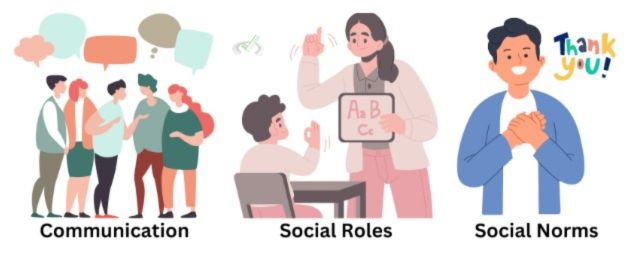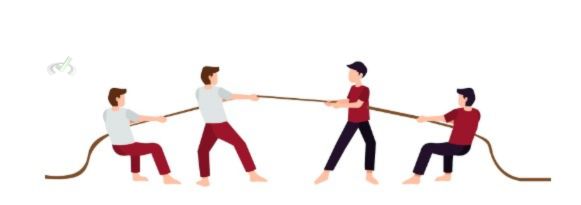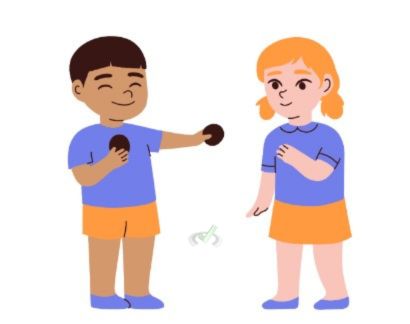Social interactions are a key part of our daily lives. They shape how we connect with others and navigate the world. This guide will help you understand the important components that make social interactions work.
I. Understanding Social Interactions
Social interactions are how we communicate and engage with others. These interactions can be as simple as a smile or as complex as a deep conversation. Here are the main elements that make social interactions happen.

Communication
Communication is how we share information, thoughts, and feelings with others. It can be verbal, using words, or non-verbal, using body language, facial expressions, and gestures. Effective communication is crucial for understanding each other and building relationships.
Social Roles
Social roles are the parts we play in our daily lives. Each role comes with expectations about how we should behave. For example, a teacher is expected to educate students, while a student must learn and follow school rules. Understanding our roles helps us know how to act in different situations.
Additional Info: Sometimes, people face "role strain," which happens when one role has too many demands. For example, a student might feel stressed with too much homework. "Role conflict" occurs when different roles clash. For instance, a person might struggle to balance being a parent and an employee.
Social Norms
Social norms are the unwritten rules about how to behave in society. They tell us what is considered acceptable and what is not. For instance, saying "please" and "thank you" are norms for politeness. Following social norms helps keep interactions smooth and predictable.
Additional Info: Social norms include different types:
- Folkways: Everyday norms based on customs, like dressing appropriately for school.
- Mores: Norms with moral significance, like being honest.
- Taboos: Strongly forbidden behaviors, like stealing.
II. Types of Social Interactions
There are several types of social interactions, each with unique features and purposes.
Cooperation

Cooperation happens when people work together towards a common goal. This type of interaction is essential in group activities, like team sports or school projects. Cooperation helps build trust and achieve objectives that might be difficult.
Competition

Competition is when individuals or groups strive to outperform each other. This can be seen in sports, academic achievements, and social status. While competition can motivate us to improve, it can also lead to stress and conflict if not managed well.
Additional Info: There is "positive competition," like friendly sports, and "negative competition," which involves hostility and trying to undermine others.
Conflict

Conflict occurs when people disagree or clash interests. It can arise from misunderstandings, differing opinions, or competing desires. While conflict can be challenging, negotiating and compromise can strengthen relationships.
Accommodation

Accommodation involves adjusting our behaviors or attitudes to resolve conflicts and maintain harmony. It often requires compromise and understanding. For example, if two friends disagree on a movie to watch, they might take turns accommodating each other's preferences.
Exchange

Exchange is a social interaction where people give and receive benefits. This can be material, like trading goods, or social, like giving compliments or support. Exchanges help build mutual trust and dependence.
Additional Info: "Reciprocity" means exchanging things for mutual benefit. For example, helping a friend with homework because they helped you before. "Social capital" is the network of relationships that provides support and cooperation, like a community group working together.
III. Factors Influencing Social Interactions
Several factors influence how we interact with others.
Culture
Culture shapes our values, beliefs, and behaviors. It influences how we communicate, what we consider polite, and how we handle conflicts. Understanding cultural differences is vital for effective social interactions, especially in diverse settings.
Social Status
Social status refers to the position a person holds in society. It can affect how others perceive and interact with them. Higher status can bring respect and influence, while lower status might lead to being overlooked or marginalized.
Personal Relationships
The nature of personal relationships also affects social interactions. We interact differently with family, friends, acquaintances, and strangers. Close relationships often involve more trust and openness than interactions with strangers or casual acquaintances.
Situational Context
The context or setting of an interaction plays a significant role. Formal settings, like schools or workplaces, have different expectations than informal ones, like hanging out with friends. Adapting to the context helps us interact appropriately.
Additional Info: Technology and digital communication are also important. Texting and social media, for example, have changed how we communicate and interact with others.
IV. Theories of Social Interaction
Understanding social interactions involves looking at different theories that explain how and why we interact in specific ways.
Symbolic Interactionism
Symbolic interactionism focuses on how people use symbols, like language and gestures, to create meaning in social interactions. It emphasizes the importance of individual perspectives and interpretations in shaping interactions.
Social Exchange Theory
Social exchange theory views social interactions as transactions where people seek to maximize rewards and minimize costs. It suggests that we form and maintain relationships based on the perceived benefits we receive.
Dramaturgical Analysis
Sociologist Erving Goffman proposed a dramatic analysis that compares social interactions to a theatrical performance. People are like actors who present themselves in ways others will accept, depending on the "stage" or situation they are in.
Additional Info: "Impression management" is how people try to control the impressions others have of them. "Front stage" is where we perform and follow social norms. "Back stage" is where we can be ourselves without worrying about social expectations.
V. Effects of Social Interactions
Understanding social interactions helps us see their positive and negative effects on individuals and society.
Positive Effects
- Building Relationships: Good social interactions help form and maintain friendships, family bonds, and professional networks.
- Learning and Growth: Interacting with others exposes us to new ideas and perspectives, aiding personal development.
- Emotional Support: Positive interactions provide emotional support, reducing stress and increasing happiness.
Negative Effects
- Conflict and Stress: Poor interactions can lead to conflicts and stress, affecting mental health and relationships.
- Social Pressure: Interactions can sometimes lead to negative behaviors, like peer pressure, where individuals feel forced to conform to group norms.
VI. Coping with Social Interactions
Developing skills to manage social interactions can improve our well-being and relationships.
Communication Skills
Improving communication skills, like active listening and clear expression, can enhance interactions. Practicing empathy helps us understand others' perspectives.
Conflict Resolution
Learning conflict resolution techniques, such as negotiation and compromise, helps manage disagreements effectively, reducing their negative impact.
Self-Awareness
Awareness of our social behaviors and their effects on others can help us interact more positively. Reflecting on our interactions can lead to personal growth and better relationships.
Additional Info: Emotional intelligence, which means being aware of and managing our emotions, is crucial for self-awareness and handling social interactions well.
VII. Bridge/Overlap
The study of social interactions connects to other important areas in sociology and beyond.
Group Dynamics
Understanding social interactions helps explain how groups form, interact, and make decisions. Studying group dynamics can reveal why some teams are more effective than others.
Social Identity
Social interactions influence our social identity or how we see ourselves in groups. Understanding social identity can help explain behaviors in different cultural contexts.
Mental Health
Positive social interactions can improve mental health by providing support and reducing stress. Negative interactions, like bullying or social isolation, can harm mental health.
Behavioral Economics
Social interactions impact decision-making and economic behavior, which is relevant for understanding consumer behavior and market trends. For example, people often follow trends or make purchases based on social influence.
Additional Info: This section extends beyond sociology and links with psychology, anthropology, and economics, making it relevant for MCAT preparation.
VIII. Wrap Up/Key Terms
Let's summarize the key points:
- Communication: Sharing information, thoughts, and feelings.
- Social Roles: Expected behaviors for different positions in society.
- Social Norms: Unwritten rules about acceptable behavior.
- Cooperation: Working together towards a common goal.
- Competition: Striving to outperform others.
- Conflict: Disagreements or clashes of interest.
- Accommodation: Adjusting behaviors to maintain harmony.
- Exchange: Giving and receiving benefits.
- Symbolic Interactionism: Using symbols to create meaning in interactions.
- Social Exchange Theory: Viewing interactions as transactions.
- Dramaturgical Analysis: Comparing social interactions to a theatrical performance.
- Role Strain: Stress from too many demands in one role.
- Role Conflict: Clash between different roles.
- Folkways: Everyday norms based on customs.
- Mores: Norms with moral significance.
- Taboos: Strongly forbidden behaviors.
- Reciprocity: Exchanging things for mutual benefit.
- Social Capital: Network of relationships providing support.
- Impression Management: Controlling how others perceive us.
- Front Stage: Where we perform and follow social norms.
- Back Stage: Where we can be ourselves without social expectations.
- Emotional Intelligence: Being aware of and managing our emotions.
IX. Practice
Test your understanding with these questions:
Sample Practice Question 1
What is cooperation?
A. Striving to outperform others.
B. Working together towards a common goal.
C. Disagreements or clashes of interest.
D. Adjusting behaviors to maintain harmony.
Ans. B
Cooperation involves people working together to achieve a shared objective.
Sample Practice Question 2
Which factor influences social interactions by shaping values, beliefs, and behaviors?
A. Social Status
B. Personal Relationships
C. Culture
D. Situational Context
Ans. C
Culture influences how we communicate, what we consider polite, and how we handle conflicts.







 To help you achieve your goal MCAT score, we take turns hosting these
To help you achieve your goal MCAT score, we take turns hosting these 





















 reviews on TrustPilot
reviews on TrustPilot